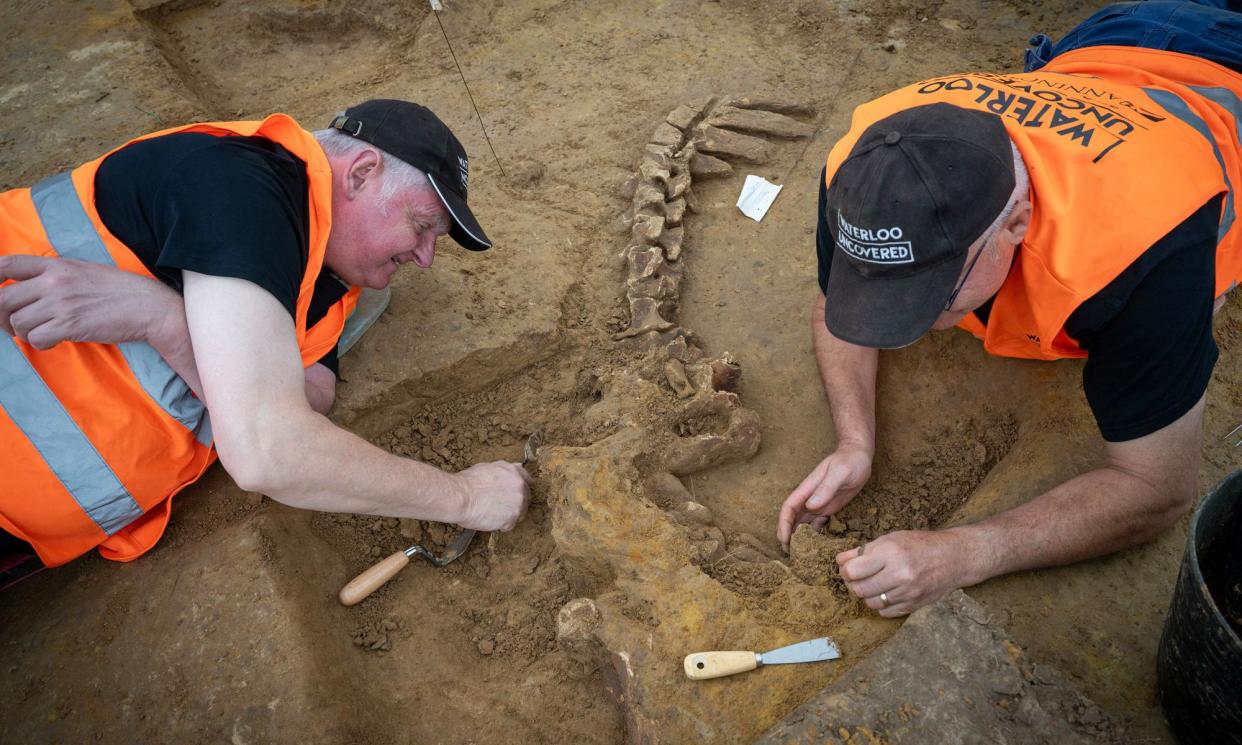Battle of Waterloo dig uncovers horror of severed limbs and shot horses

The carnage and horror of the battle of Waterloo have been laid bare in an excavation by military veterans and archaeologists that has uncovered amputated limbs and the remains of horses which were shot to be put out of their misery.
At least 20,000 men – and possibly many more – were killed in the epic 1815 battle when the British military officer the Duke of Wellington and a European alliance defeated Napoleon’s French forces in a decisive and bloody encounter that determined the power balance in Europe for nearly a century.
More than halfway through a two-week dig at Mont-Saint-Jean farm, in Belgium, which served as Wellington’s field hospital, researchers have uncovered 15 severed limbs, the skeletons of seven horses and one and a half cows, in addition to the three horses and complete human skeleton uncovered at the same site in 2022.
Archaeologists returned this month to what they say is a “purposefully dug pit likely designed to quickly clear the hospital of gore” after the battle.
Tony Pollard, a historian and archaeologist at the University of Glasgow, said: “On other Napoleonic battlefields, we have burial pits with humans. We have pits with horses. We even have pits with horses and humans. Nowhere else in the archaeological record do we have this combination of limbs, a burial and euthanised horses.”
Sitting near him, archaeologists working with toothbrushes painstakingly brushed clay soil from tin ammunition boxes, which were also found in the pit, located in an apple orchard. Stripped out of leather bags, the boxes were discarded, probably because they were too damaged.
“What we’ve got there is a snapshot of what happens after the battle,” Pollard continued. “That includes the stripping of all of the uniform elements from a dead soldier, the putting out of the misery of wounded horses, eating and continuing to survive.” The skeleton of the complete cow shows signs of butchery, suggesting it was used for food.
Pollard is the academic lead of Waterloo Uncovered, a veteran support charity, which organised the dig.
Clive Jones, a volunteer at the dig and Welsh Guards veteran, said uncovering the horses brought back memories of the Hyde Park bombing of 1982, which killed four military personnel and seven cavalry horses. Seven army band members were killed in an attack at Regent’s Park on the same day.
Jones, then stationed with the household cavalry in Knightsbridge, was drinking coffee in the stables when he heard the clattering of hooves. “And three horses came galloping up the ramp, back into the stable area, and each one went back in its own stall where it lived,” he recalled. “They were pouring with blood.”
More than 42 years later, uncovering the horse skeletons at Waterloo brought that day back. “[It] makes me think about the suffering of the horses in 1982 … and that surprised me.
“I just had the vision of this horse hobbling to the side of this ditch [in 1815] on three legs and then being put down [and] I was [back to] what I saw in 1982 in Knightsbridge.”
He said the dig and broader network offered by the charity offered veterans “a safe environment”, where they could tell “stuff that they couldn’t tell to somebody who’d never been in the military”.
John Dawson was shot in the head while serving with the Grenadier Guards in Helmand province in 2012, losing his right eye and the use of his left arm. After major surgery to reconstruct the right side of his head and “fighting hard” to regain the ability to walk, the trip to Belgium was his first without a support worker. Initially sceptical, he said he would recommend the dig to others: “It is just like being in the army again; the camaraderie between everyone is just very good, even those who have not been in the military.”
As to whether the experience could trigger trauma, he said: “The only good thing to come out of my injury: I can’t remember any of that sort of thing.”
The Waterloo Uncovered digs, which began in 2015 on the 200th anniversary of the battle, had helped provide “a more balanced picture” than the British-dominated accounts in history books, Pollard said, which tended to leave out other nations.
The excavations have also revealed the intensity of the fighting at the Hougoumont farmhouse, known as the killing ground, where 1,200 allied soldiers sought to hold off far greater numbers of French attackers.
British accounts have long claimed the French never got into the Hougoumont garden. The archaeological work – forensic mapping of lead musket balls – by the project shows otherwise, shedding new insights on the ferocity of that battle within a battle.
Pollard said: “We have evidence for a close-quarter gunfight, firefight inside so the French had actually got over the wall, but probably only in very small numbers, and were probably killed quite quickly.”
Lining up against Napoleon’s forces were troops from Great Britain, Prussia, the Netherlands, the lands that became Belgium, as well as Hanover, Brunswick and other German states.
Historians have estimated about 500 limbs of soldiers from Wellington’s alliance were amputated at Mont-Saint-Jean, without anaesthetic or antibiotics.
More than two centuries later, excavators have been struck by the cleanness of the cuts. But nothing is known about the fate of the men who suffered the agonising surgery. It was “in the lap of the gods whether they lived or died”, Pollard said.


